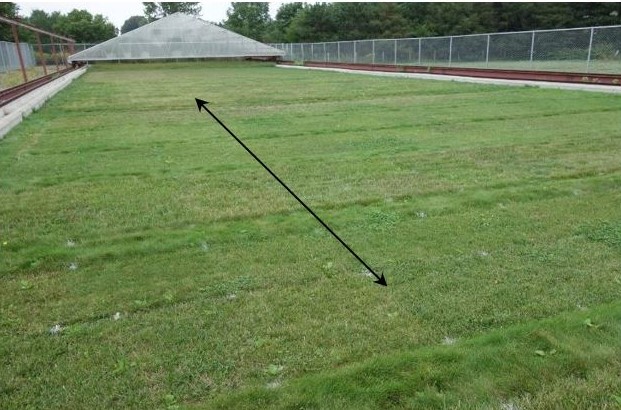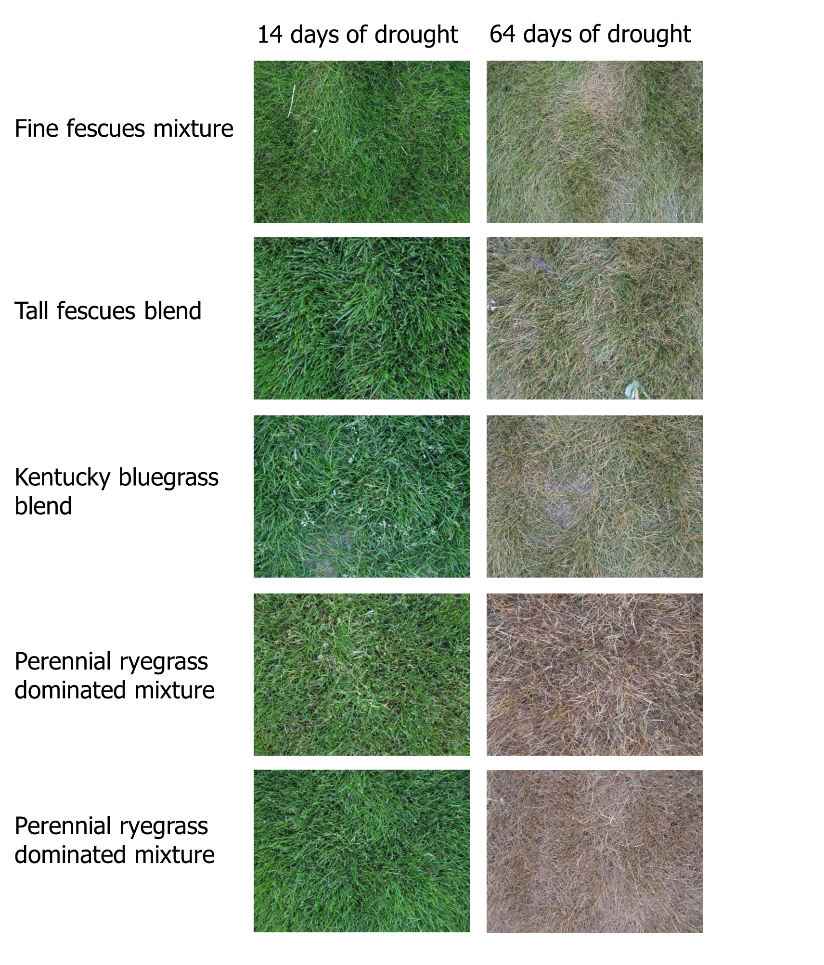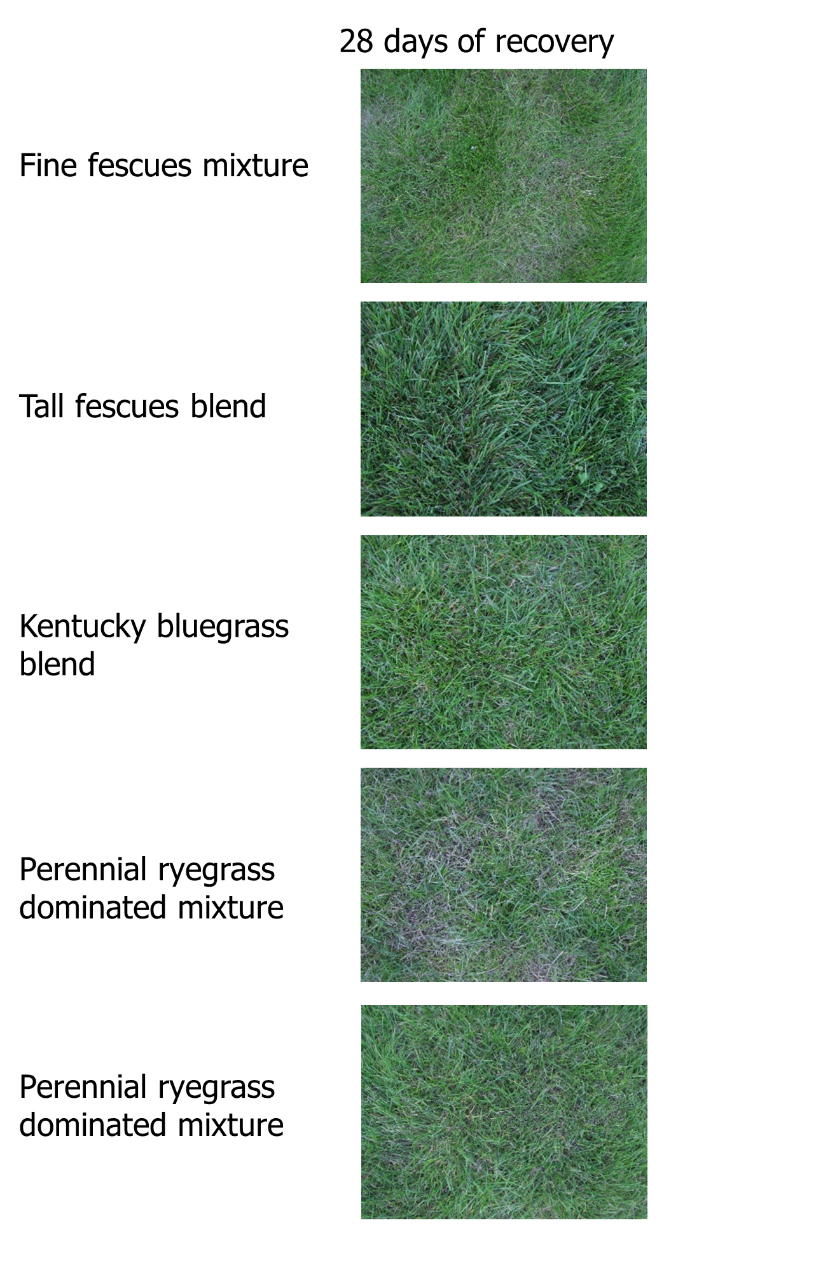By Florence Sessoms
The presence of lawns in urban environments is sometimes viewed negatively: too many chemical inputs that result in environmental pollution. I also have observed a popular misconception about irrigation on home lawns: irrigation is compared to the Danaides’ barrel (Figure 1), a bottomless pit where water is forever added and lost. However, lawns can provide tremendous ecosystems services such as decreased soil erosion, absorption of dust and particle pollution, reduced heat island effect, and increased mental and physical human health.
The first project I worked on in relation to water conservation was a project developed by Sam Bauer and Dr. Brian Horgan sponsored by The Metropolitan Council. A part of this project was to evaluate the drought tolerance of consumer available seed mixtures. We typically recommend the use of mixtures because the combination of several species provides a better tolerance toward environmental stresses. However, mixtures that are available to consumers possess various species compositions and little was known on the overall mixtures tolerance after a prolonged period of drought.
| Species | Benefit for mixtures | Drought tolerance |
|---|---|---|
| Perennial ryegrass | Fast establishment | NO |
| Annual ryegrass | Fast establishment | NO |
| Tall fescue | Heat tolerant | YES |
| Kentucky bluegrass | Heat tolerant, winter hardy | YES |
| Fine fescues (Chewings, hard, sheep, creeping red) | Slow growth, low fertilizer input | Depends on the species |
| Rough bluegrass | Shade tolerant | NO |
| Alkaligrass | Salt tolerant | NO |
Before the drought stress experiment started, plots were mowed at 2 inches (low mow) or at 3.5 inches (high mow); the mowing treatments continued weekly during the whole experiment. We decided to subject the mixtures to long periods of drought (over 50 days) as an extreme example since the longest drought period in St. Paul (MN) without measurable precipitation occurred in 1942 and lasted 51 days. Each week, I took pictures of each plot with a customized light box and also rated each plot for turf quality. I analyzed these digital images to estimate the amount of green cover during the entire drought stress. The amount of green cover observed weekly allowed me to determine the green stability during the whole drought period. Altogether this research led to four important points:
1. Species composition affects plots tolerance to drought
My analysis revealed that the species composition affects green stability during long periods of drought. Mixtures possessing a higher proportion of tall fescue or Kentucky bluegrass stayed green longer (Figure 3).
The presence of fine fescue species in mixtures led to various responses of drought tolerance. The presence of Chewings and strong creeping red fescues was more detrimental than the presence of sheep and hard fescue. We concluded that the variable response of the fine fescue dominated mixtures could have originated from the various species used in our study.
It is important to note that increasing the amount of non-drought tolerant species, such as perennial ryegrass, annual ryegrass, alkaligrass and rough bluegrass in a mixture led to reduced green stability. It seems that the presence of drought-susceptible species could counterbalance the overall drought tolerance of the mixtures. Species composition of the seed mixtures that are originally sown will not stay the same over time. An aggressive drought-susceptible species like perennial ryegrass or rough bluegrass might increase in proportion prior to the onset of drought stress. After a couple months of establishment, the mixtures could be more dominated by these non-drought tolerant species resulting in lower drought tolerance.
2. All plots recovered from the drought
Each acute drought stress was followed by a recovery period of 28 days during which the plots received one inch of water twice a week. Importantly, all plots recovered from the drought (Figure 4).
3. Mowing height can affect the tolerance to drought and the recovery for short periods of time
The amount of green cover for both mowing heights was affected similarly at the end of these acute drought periods. For homeowners, different mowing practices lead to similar results after a long period of drought. However, I observed that the green stability of the plots differed between the two mowing heights. The high mow plots displayed a longer green stability than the lower mowing height. This means that the high mow plots would have a higher amount of green cover for shorter periods of drought, a likely occurrence given Minnesota climate future predictions.
At the end of the recovery period, I did not observe any difference for amount of green cover between the two mowing heights. When I looked at the early recovery (7 days of recovery), I observed that the low mow plots presented a higher amount of green cover than the high mow. Plots with higher mowing heights had greater amounts of dead leaf tissue still present, while plots mowed at lower heights would have had most of the dead tissue removed during mowing. Homeowners who want to improve the early recovery of their lawn should mow at a lower mowing height at least once near the beginning of the recovery period.
4. Homeowner management influences water conservation
I believe that higher water conservation can be improved only if homeowners modify their management practices and adjust their expectations. The choice of appropriate species is the first step to reduce water consumption on lawns. Seed mixtures containing tall fescue and fine fescue species should be promoted. Kentucky bluegrass containing seed mixtures are also more drought tolerant, but Kentucky bluegrass requires more fertilizer inputs. Second, irrigation is not required for short seasonal drought. All plots in our research recovered from the acute drought stress. Third, higher mowing height helped drought tolerance of the plots. So in conclusion I recommend that during our summer seasonal droughts to turn off your irrigation system. Leave your lawn alone and enjoy a cold refreshing drink. Cheers!



